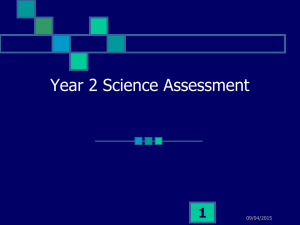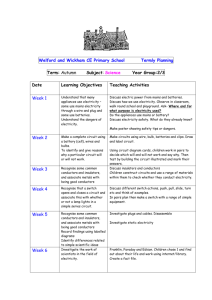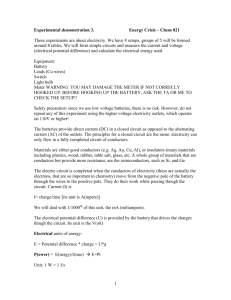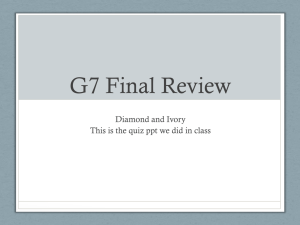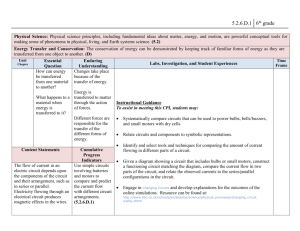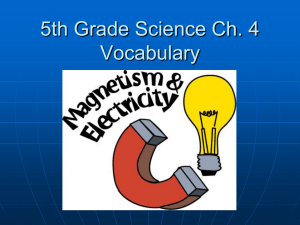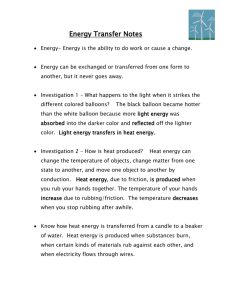GRADE 6 QUESTION BANK
advertisement
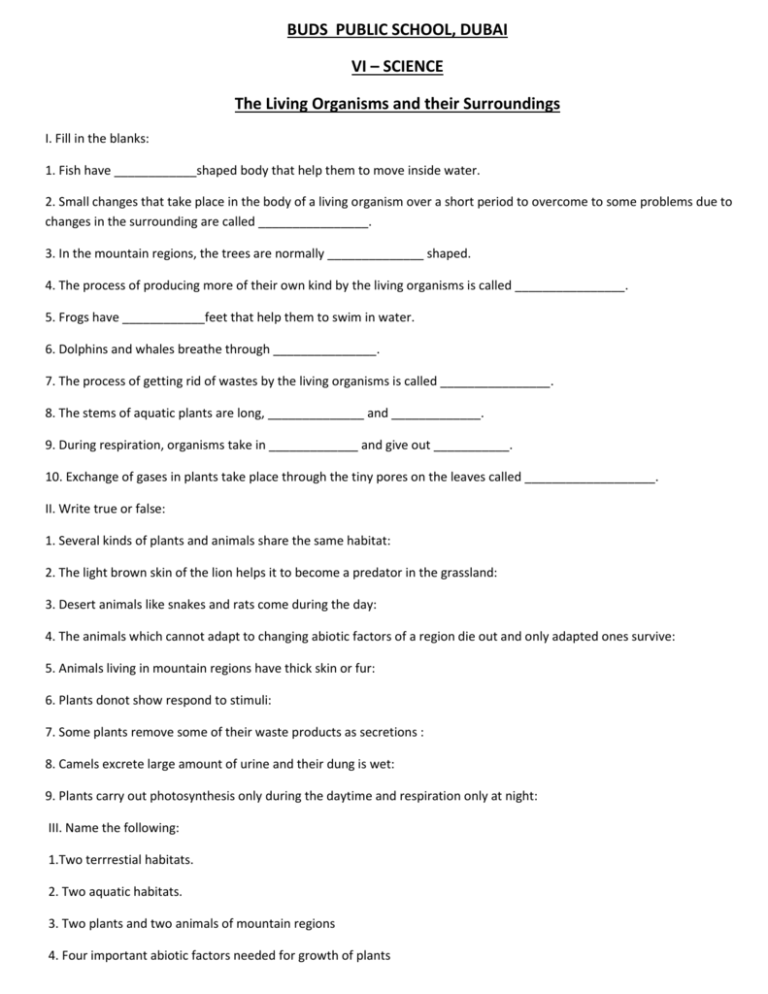
BUDS PUBLIC SCHOOL, DUBAI VI – SCIENCE The Living Organisms and their Surroundings I. Fill in the blanks: 1. Fish have ____________shaped body that help them to move inside water. 2. Small changes that take place in the body of a living organism over a short period to overcome to some problems due to changes in the surrounding are called ________________. 3. In the mountain regions, the trees are normally ______________ shaped. 4. The process of producing more of their own kind by the living organisms is called ________________. 5. Frogs have ____________feet that help them to swim in water. 6. Dolphins and whales breathe through _______________. 7. The process of getting rid of wastes by the living organisms is called ________________. 8. The stems of aquatic plants are long, ______________ and _____________. 9. During respiration, organisms take in _____________ and give out ___________. 10. Exchange of gases in plants take place through the tiny pores on the leaves called ___________________. II. Write true or false: 1. Several kinds of plants and animals share the same habitat: 2. The light brown skin of the lion helps it to become a predator in the grassland: 3. Desert animals like snakes and rats come during the day: 4. The animals which cannot adapt to changing abiotic factors of a region die out and only adapted ones survive: 5. Animals living in mountain regions have thick skin or fur: 6. Plants donot show respond to stimuli: 7. Some plants remove some of their waste products as secretions : 8. Camels excrete large amount of urine and their dung is wet: 9. Plants carry out photosynthesis only during the daytime and respiration only at night: III. Name the following: 1.Two terrrestial habitats. 2. Two aquatic habitats. 3. Two plants and two animals of mountain regions 4. Four important abiotic factors needed for growth of plants 5. Breathing organs of fish and earthworms. 6.Any three modes of reproduction by plants. IV. Define the following: i. Adaptation ii. Stimuli V. Distinguish between: i. Biotic and abiotic factors. ii.Terrestrial organisms and aquatic organisms. VI. Draw, colour and label: 1) a desert plant. 2) an aquatic plant VII. PROJECT: Stick pictures of any two plants and two animals belonging to each of the following habitats: 1.Deserts 2. Mountain regions 3. Grasslands 4. Ponds/lakes. VIII. Fill in the blanks : 1. Organisms in oceans are surrounded by _______________ water. 2. Gills help fishes to use ______________ dissolved in water. 3. Plants and animals living on land belong to ______________ habitat. 4. Photosynthesis in desert plants is carried out by the _______________. 5. Exchange of gases in plants takes place through ________________. 6. In mountain regions trees are normally ______________ shaped and have ______________ branches. 7. Changes in our surroundings that make us respond are called _______________. 8. Animals like rats and snake live in ______________ during day to stay away from heat. 9. Breathing is a part of the process of ______________. 10. ________________ protect the fishes and help in easy movement through water. IX. Write True or False : 1. Animals and plants are abiotic factors. 2. Dolphins and whales do not have gills. 3. Skin of fishes is covered with scales. 4. Leaf like structure in cactus is its stem. 5. Yak is adapted to mountain habitat. X. Give answer in one or two words : 1. Give 2 examples of aquatic habitat. 2. Give 2 examples of terrestrial habitat. 3. Give 2 examples of aquatic plants. 4. Name two animals found on mountains. Motion And Measurement Of Distances I Mention the type of motion taking place in : 1. The horse pulling a cart 2. Earth moving around the sun in its orbit 3. A child playing with a top 4. A coin moving over a carom board 5. A ball fixed to string 6. Motion of a branch of a tree when it shaken heavily. II State True (T) or False (F) against the following statements : a. Handspan cannot be used to measure length all over the world. b. Ten millimeter is equal to 1 metre. c. Motion and rest are different terms d. To measure the diameter of tree, you can use measuring tap or thread. e. Kilometre is the SI unit of length. f. Length of curved line cannot be measured by metre scare directly. III Fill in the blanks : 1. 1000 times the length of a metre is called ___________. 2. The 1/1000 part of a metre is called __________. 3. The motion which repeats itself after a fixed interval of time is called ________________ motion. 4. The motion described by a violin string is _____________ motion. Light, Shadows And Reflections I) Fill in the blanks : 1. _____________________________ helps us to see objects. 2. Objects that give out or emit light of their own are called ___________________. 3. ______________________objects allow light to pass through them completely. 4. ______________________ objects do not allow the light to pass through it at all. 5. _______________________ objects allow the light to pass through them partially. 6. Light travels in a ______________________________. 7. _____________________ are formed when an opaque object comes in the path of light. 8. ______________________ and ____________________ objects are essential for the formation of shadows on a screen. 9. A shadow cast by the heavenly bodies is called an ______________________. 10. Images formed by a pin –hole camera are ___________________________ 11. We see ________________________ of the object in the mirror. II) Answer in one or two words : 1. Give two examples of opaque objects. 2. Give two examples transparent objects 3. Give two examples of translucent objects. 4. Give two examples of luminous objects 5. Give two examples of non-luminous objects. III) Choose the correct Answer : 1. [Mirror/glass] helps to change the direction of light that falls on it. 2. Images are [ same / different] from the shadow. 3. Torch bulb is [ luminous / non – luminous object] 4. [opaque/transparent] objects cast shadows. 5. Coloured objects form [coloured / dark] shadows. IV) Answer the following questions : 1. How are shadows formed ? 2. What is meant by reflection of light ? 3. Explain with the help of an activity that light travels in a straight line. V) Define : 1. Opaque objects 2. Shadows 3. Reflection of light VI) Distinguish between 1. Transparent and translucent objects 2. Luminous and non luminous objects. Fill in the blanks: 1. All sources of light can be classified into two categories _______ and ____________________ 2. Moon and planets do not emit light of their own, but they reflect the light of the ____________________ falling on them. 3. A non-luminous body can be made luminous by ____________________ it. 4. A source of light which is of the size of the head of a common pin is called ____________________ source of light. 5. A collection of a large number of rays of light is called a ____________________ of light. 6. The property of light by which it travels in a straight line is called -____________________ propagation of light. 7. The image formed in pinhole camera is ________________, _________________, ____________________ in size. Answer the following : 1. Two differences between a shadow and an image formed in pin-hole camera. 2. How much time the light from the sun takes to reach the earth ? 3. Define mirror. Electricity And Circuits I. Fill in the blanks: 1. The electric energy which is supplied in our home comes from electric ____________________houses. 2. Diesel __________ is generally used in big factories or at public functions as a standby. 3. The battery ____________________ is uses at homes, offices and hospitals. 4. The tiny coiled wire which is supported by two thick wire inside the bulb is called -______ 5. Electric cell is a device which converts energy of chemicals ___________________energy. II. Name the following: 1. A combination of two or more cells 2. An electric device which converts electric energy into light energy 3. An electric circuit in which path of electricity is broken at some point is called III. Choose the correct answer: 1. An electric bulb has (two/one) terminals. 2. The base of an electric cell is its (negative/positive) terminal. 3. All metals are (conductors/Insulators) of electricity. IV. Distinguish between Conductors and Insulators. V. Name the five transformations of electric energy. Electricity And Circuits I. Fill in the blanks : 1. The electric energy which is supplied in our homes comes from electric ______________ houses. 2. Diesel ________________ is generally used in big factories or at public functions as a standby. 3. The battery _________________ is used at homes, offices and hospitals. 4. The tiny coiled wire which is supported by two thick wire inside the bulb is called ___________. 5. Electric cell is a device which converts energy of chemicals into ______________ energy. II. Name the following : 1. A combination of two or more cells. 2. An electric device which converts electric energy into light energy. 3. An electric circuit in which path of electricity is broken at some point is called. III. Choose the correct answer : 1. An electric bulb has ( two / one ) terminals. 2. The base of an electric cell is its ( negative / positive ) terminals. 3. All metals are ( conductors / Insulators ) of electricity IV. Distinguish between : Conductors and Insulators V. Name the five transformations of electric I Fill in the blanks : 1. An electric ______________ is a continuous path along which the current flows. 2. A circuit in which electricity does not flow is called an ______________ circuit. 3. The source of electricity in an electric cell are the ______________ stored in it. 4. Rubber is a good example of electric ______________. 5. A device that is used to break of complete an electric circuit is called ______________. 6. An electric cell has ______________ terminals. 7. If the filament of a bulb breaks, it is said to be ______________. 8. An electric current is ______________ when no current flows through it. 9. Electric current flows from ______________ terminal to ____________ terminal of cell in the circuit. II Give one word for the following statements : 1. The source of electricity _____________________ 2. Thin wire in a bulb which gives out light ____________________ 3. The arrangement of providing a complete path for electricity to pass between two terminals of the electric cell ____________________ 4. Some times electric bulb does not glow even when electric switch is „ON‟ then we say that bulb is ____________________ 5. An electric appliance which makes or breaks an electric circuit ____________________ III Mark True (T) or False (F) for following statements : a. Electric current can flow through metals. b. Instead of metal wires, a jute string can be used to make a circuit. c. Electric current can pass through a sheet of thermocol. d. When current flows through a circuit, the circuit is called open circuit. e. Electric current can easily flow through Copper. f. When an electric circuit is closed, the electric current stops flowing through it. IV Tick the correct answer : 1. Choose a good conductor from the following materials. a) Pencil lead b) Thermocol c) Wooden block 2. Which of the following is not a good conductor of electricity. a) Mercury b) Copper c) Plastic d) Aluminum foil 3. Switch is „OFF‟ when a) circuit is complete b) Circuit is not complete c) Current is flowing in the circuit d) Cell is fully charged
